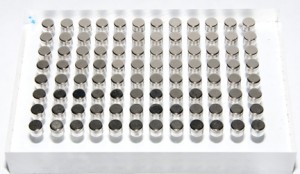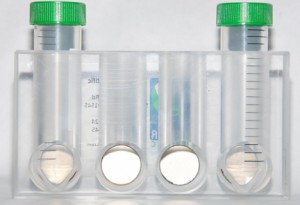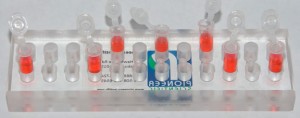Magnetic bead based separation of cells, extraction of DNA and RNA are very commonly employed in the laboratories. This method is suitable for automation and processing by automated liquid handling robots offered by a number of vendors. It is relatively fast, easy and cost effective. Magnetic particle based cell separation can be used to isolate specific cell population from a heterogeneous mixture of cells based on their specific cell surface antigen (CD Molecules). Magnetic beads are either nano particles, tagged with specific antibody, or mono beads as in Dynabeads (Invitrogen).
For one method, cells are incubated with magnetic nanoparticles coated with antibodies against specific surface antigen of the target cell. This allows the cells with that antigen to attach to the magnetic particle. Afterwards the cells in solution are passed through a column placed in a magnetic field. This method can be used for a positive selection or negative selection. For positive selection, cells expressing the antigens of interest are attached to the column, while the non-specific cells will flow through to a collection vessel. Later the desired cells, which are bound to the column, can be collected. For negative selection, cells which are not interested, are tagged with specific antibody for them. When the cell solution is passed through, the unwanted cells will be bound to the column and the desired target cells will flow through and will be collected in a vessel.
For the second method cells of interest are tagged with magnetic particles attached with specific antigen by incubating with them. After a certain period of time when the cells are bound to the magnetic particles, the cells in a 96 well multiwall plate, or tubes are placed next to a powerful magnetic rack. The cells of interest will be bound to the tube close to the magnet because of the magnetic attraction. The un attached, non specific cells can be washed off. Depending on the volume and number cumber of cells magnetic rack can be 96 well plate, 2 ml centrifuge tubes, 15 ml or 50 ml centrifuge cells. Pioneer Scientific (www.pioneerscientific ) offers three different format of magnetic racks or stands to fit your needs. The same method can be used for extracting DNA or RNA from blood or tissue extract. Magnetic particles are coated with specific chemistry, which will bind to DNA or RNA. The blood or tissue extract is mixed with lysis buffer with expose the nucleic acid. This mixture is then incubated with magnetic or paramagnetic particles, which will bind specific to DNA or RNA based on the chemistry. After the binding step, the unbound material is washed off and the nucleic acid bound to the magnetic particles is eluted and the DNA or RNA is collected. The MAG96, MAG2, and MAG50 can be used for this separation based on the sample volume. Magnetic particle based separation of cells or nucleic acid (DNA or RNA) is an effective, automation friendly way to isolate specific cell population or nucleic acid for further analysis.



